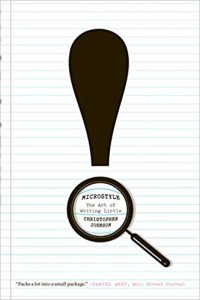Microstyle: The Art of Writing Little, by Christopher Johnson
Microstyle: The Art of Writing Little
By Christopher Johnson
W.W. Norton & Company
Four Stars
Reviewed by Jessica Gribble
Reading Microstyle is like understanding how advertising works. (That’s my microstyle review. You’ll have to read the book to find out if it’s any good.)
At the end of the introduction, author Christopher Johnson establishes his bona fides, which are impressive. He’s a linguist who designed himself an interdisciplinary college program at the University of Chicago: linguistics, philosophy, and psychology. Then he got a PhD from UC Berkeley and worked as a namer and name analyst at Lexicon Branding. He’s taught linguistics and developed ways to model linguistic meaning for software applications. Even though Johnson has spent a lot of time in academia, he’s focused on applying these ideas to the real world. In short, he really knows what he’s talking about!
Microstyle is divided into four parts: Meaning, Sound, Structure, and Social Context. Each prescriptive chapter tells readers how to make their miniature messages “grab attention, communicate instantly, stick in the mind, and roll off the tongue.” For instance, chapters are called “Choose the Right Word,” “Zoom In on Telling Details,” “Play with Poetic Patterns,” “Teach an Old Cliché New Tricks,” and “Establish a Relationship.” Johnson does a great job in the introduction of explaining why our language now emphasizes micromessages and how technology, including the Internet and social media, has enabled that change. The tools he discusses in the book are intended to help writers get a lot of idea out of a little message (a micromessage).
The audience for this book is anyone who writes, for work or for fun. So many of us are competing for attention, whether it’s to advertise a product or to share information about ourselves, that it’s crucial to make other people notice our words. However, this isn’t a scary book with lots of formal rules about how to write correctly. Instead, it’s easy to read and full of interesting information about language and how it works in the world. For instance, I learned about “crash blossoms,” which is a type of newspaper headline that doesn’t work at all. The name comes from one such headline: “Violinist Linked to JAL Crash Blossoms.” This is a linguistic example of ambiguity in a sentence that could have been clear if it had been re-written. Johnson teaches us to choose a name for a company or title based on how easy it is to pronounce when you see it written down: Kodak is much easier than Adapx. He points out how alliteration brings poetry to movie, book, and TV titles (Pride and Prejudice, Dawn of the Dead). We learn about theories of syntax and how hard it is to account for idioms like “kick the bucket.” We even hear that it’s okay to make up a new word. Johnson tells the story of the word “bacn,” which was coined at PodCamp Pittsburgh 2 by a few social media geeks who were talking about international types of bacon while receiving messages on their mobile devices. Eventually, “a new word was born: bacn, which the group defined as ‘email you want, but not right now.’”
Microstyle is a fun read for people who love to think about language. Johnson is terrific at providing examples of real-world language use, and readers will become much more aware of how advertisers, bloggers, media companies, and even regular people draw attention to their content. But as a writing guide, it’s as difficult to use as the famous Elements of Style; even if you can recognize good microstyle, it’s still really hard to generate it, especially if you’re trying to remember twenty-three different ways style can be put to your advantage.
